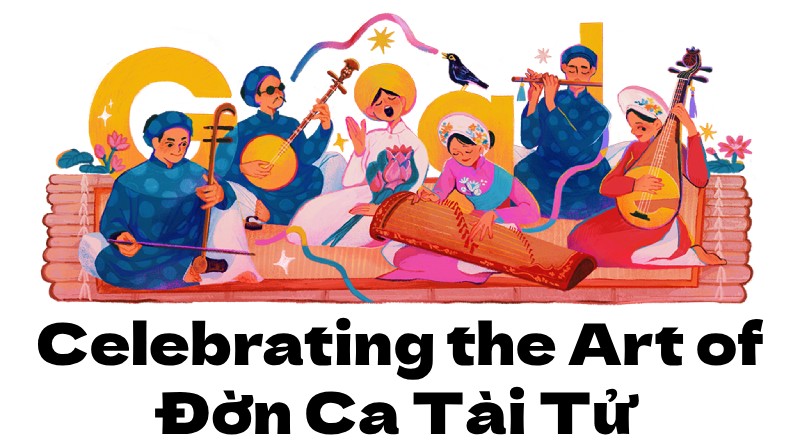Festivals & Events
Interesting Facts about Đờn Ca Tài Tử, a National Music Genre of Vietnam

The art of Đờn Ca Tài Tử, a traditional genre of chamber music from southern Vietnam, is honored in today’s Google Doodle. This Google Doodle honors and showcases the music genre of Đờn Ca Tài Tử, which is Vietnamese culture. The artwork features musicians performing Đờn Ca Tài Tử, and it was illustrated by guest artist Camelia Pham. The art form was officially designated as an Intangible Cultural Heritage of Humanity by UNESCO on this day in 2013.
20 Interesting Facts about Đờn Ca Tài Tử
- Don Ca Tai Tu Southern music is a national music genre of Vietnam that has a wide influence spanning 21 southern provinces and cities. It was recognized by UNESCO as an intangible cultural heritage on December 5, 2013, and it holds this title in Vietnam.
- The genre known as don ca tai tu originated in Hue royal court music, folk literature, and ceremonial music in the late 1800s.
- A typical folk art form in the South is don ca Tai Tu. This is a kind of music and singing that is performed by common people in the Southern countryside after work, including young men and women.
- Don Ca Tai Tu is a kind of performance with a band made up of four types of instruments: pliers, stork, zither, and monochord (called quartets). It first appeared more than a century ago. A concave fret guitar was eventually used in place of the bass guitar, which was an inventive move.
- The majority of those taking part in Don Ca Tai Tu are neighbors and friends. They are often not particular about clothes because they get together to enjoy sophisticated pleasures.
- This kind of music is actually a kind of chamber music that is frequently played in intimate settings, like homes, weddings, anniversaries of deaths, birthday celebrations, festivals, the evenings after harvesting crops, and typically on moonlit nights in the village.
- Hue music, combined with music from the provinces of Quang Nam and Quang Ngai, is the source of Don Ca Tai Tu. This is not ceremonial music; this is entertainment music.
- In 21 South Vietnamese provinces and cities—An Giang, Bac Lieu, Ben Tre, Binh Duong, Binh Phuoc, Binh Thuan, Ba Ria–Vung Tau, Ca Mau, Can Tho, Dong Nai, Dong Thap, Hau Giang, Kien Giang, Long An, Ninh Thuan, Soc Trang, Tay Ninh, Tien Giang, Tra Vinh, Ho Chi Minh City, and Vinh Long—the art of Don Ca Tai Tu is presently being developed. Of them, the provinces and cities with the highest concentration of amateur music singers are Bac Lieu, Binh Duong, Tien Giang, and Ho Chi Minh City.
- The zither, the pipa, the pliers, the stork, the tam, and the flute—typically an accompanied seven-hole flute—are among the musical instruments used in “Don Ca Tai Tu”.
- Concave fret guitars are a new guitar type that has been modified by Vietnamese artisans. Because of its recessed compartments, this kind of instrument has a high sound that most closely resembles a Vietnamese musical instrument. Seldom is the flute played.
- The band, also known as a five-piece band, typically consists of the zither, pipa, pliers, stork, and tam, among other five musical instruments. There’s also the sound of a flute, typically a seven-hole flute.
- The original repertoire of Southern amateur folk music consisted of 20 basic songs that were performed and sung.
- Apart from Vong Co, short ban songs were also commonly used in activities and performances in addition to the 20 Ban To songs, which are the origins of Don ca tai tu in the South. Well-known examples of these include Van Thien Tuong, Suong Chieu, Tu Anh, Binh Sa Lac Nhan, Doan Khuc Lam Giang, and Phi Van Diep Khuc.
- The songs of Don Ca Tai Tu mixed with the rhythms of Southern Folk Songs served as the original inspiration for the music of Cai Luong.
- Later on in its development, Cai Luong adapted techniques from nearby countries to fit his particular style of performance.
- Cai Luong Ho Quang is a typical example of Beijing opera and Cantonese opera melodies mixed with traditional Cai Luong songs.
- In terms of how to use Don Ca Tai Tu music in Cai Luong, we frequently need to consider the plot and select songs that fit the moment while also drawing the audience in and bringing the story to a peak.
- Ward 2, Bac Lieu City, is home to the Southern Don Ca Tai Tu Art Memorial Area and Musician Cao Van Lau. This ambitious project pays tribute to the South’s Don Ca Tai Tu art and the gifted musician Cao Van Lau (1892-1976). Furthermore, this is an important project for the 2014 Bac Lieu National Don Ca Tai Tu Festival, which will take place.
- In Vietnam, there’s always a good reason to enjoy Đờn Ca Tài Tử. Every celebration, including birthdays, weddings, anniversaries, and Tết (Vietnamese New Year), features a lot of music. For many generations to come, it will serve as a bridge between the community through shared cultural experiences, artwork, and music.
- On December 5, 2023, Google featured a Google Doodle on its homepage to celebrate the Art of Đờn Ca Tài Tử.
-

 Tech3 weeks ago
Tech3 weeks ago12 Essential Marketing Tools Every Small Business Owner Should Try
-

 Business4 weeks ago
Business4 weeks agoSmart Strategies to Stay One Step Ahead in a Competitive Market
-

 Business4 weeks ago
Business4 weeks ago9 Low-cost Marketing Strategies and Ideas That Offer a Good Return on Investment for Small Businesses
-

 Startup2 weeks ago
Startup2 weeks agoEssential Tips for New Retail Business Owners to Succeed in a Competitive Market
-

 Tech4 weeks ago
Tech4 weeks agoHow Small Business Can Start with Marketing Automation Software
-

 Tech6 days ago
Tech6 days agoAdobe Partner with Benny Blanco to Help Small Business Branding in ‘Create Anything’ Campaign
-

 Business3 weeks ago
Business3 weeks ago7 Essential Investment Success Tips Every Investor Should Know: How to Beat the Market
-

 Tech3 weeks ago
Tech3 weeks agoGoogle’s Change to Google Local Services Ads Could Have an Impact on Millions of Small Businesses























